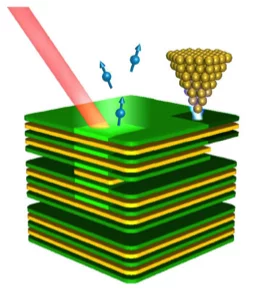The origin of colossal magnetoresistance (CMR) in manganese oxides is among the most challenging problems in condensed- matter physics today. The true nature of the low-temperature electronic phase of these materials is heavily debated. By combining photoemission and tunnelling data, we show that in the archetypal bilayer system La2-2xSr1+2xMn2O7, polaronic degrees of freedom win out across the CMR region of the phase diagram. This means that the generic ground state of bilayer manganites supports a vanishing coherent quasi-particle spectral weight at the Fermi level throughout k-space. The incoherence of the charge carriers, resulting from strong electron–lattice interactions and the accompanying orbital physics, offers a unifying explanation for the anomalous charge-carrier dynamics seen in transport, optics and electron spectroscopies. The stacking number N is the key factor for true metallic behaviour, as an intergrowth-driven breakdown of the polaronic domination to give a metal possessing a traditional Fermi surface is seen in this system.
Facility: SLS
F. Massee, S. de Jong, Y. Huang, W. K. Siu, I. Santoso, A. Mans, A. T. Boothroyd, D. Prabhakaran, R. Follath, A. Varykhalov, L. Patthey, M. Shi, J. B. Goedkoop & M. S. Golden
Nature Physics (2011)
Published online 11 September 2011
DOI: http://dx.doi.org/10.1038/nphys2089
Paul Scherrer Institut, 5232 Villigen PSI, Switzerland
Email: ming.shi@psi.ch / luc.patthey@psi.ch
Reference
Bilayer manganites reveal polarons in the midst of a metallic breakdownF. Massee, S. de Jong, Y. Huang, W. K. Siu, I. Santoso, A. Mans, A. T. Boothroyd, D. Prabhakaran, R. Follath, A. Varykhalov, L. Patthey, M. Shi, J. B. Goedkoop & M. S. Golden
Nature Physics (2011)
Published online 11 September 2011
DOI: http://dx.doi.org/10.1038/nphys2089
Contact
Dr. Ming Shi and Dr. Luc PattheyPaul Scherrer Institut, 5232 Villigen PSI, Switzerland
Email: ming.shi@psi.ch / luc.patthey@psi.ch
